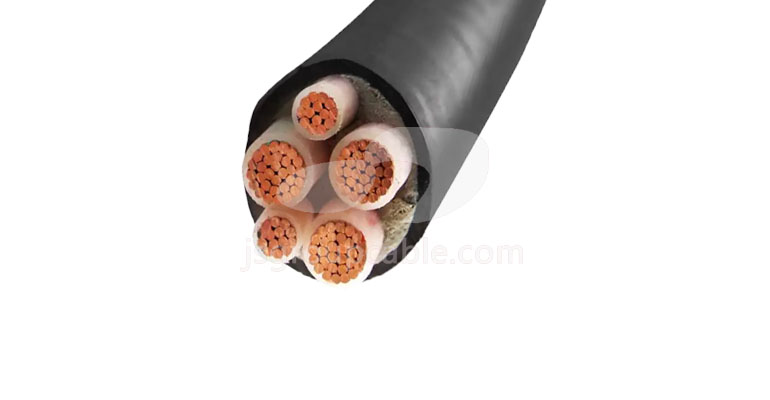- Offices Time:24 Hours Online
- Email:[email protected]
- WhatsApp:+8618339938759

Posted on November 23, 2022
Structure and main features of high temperature cables
The high temperature cable is a cable whose conductor material is a multi-strand soft copper conductor. High temperature wires and cables are generally determined by two requirements. The first is that the working environment temperature of wire and cable is relatively high, and the cable can normally transmit signals or electric energy under high temperature for a long time; the other is power transmission cable, the main function is to increase the interception capacity.
General wires and cables use plastic and rubber as insulating sheaths. These materials are conventional engineering materials with abundant sources, which can meet mass production, and the cost is relatively low. However, for some special industries such as petrochemical, steel, aerospace, shipbuilding, military industry, pharmaceuticals, food, plastic machinery, boilers and other industries related to high temperature, wires and cables that can withstand a certain high temperature are required. Ordinary wires and cables are obviously It cannot be used, and wires and cables that can withstand high temperatures are needed to ensure the safe operation of its power and signals.
1.Structural parameters of high temperature cables
Conductor material: multi-strand soft copper conductor;
Insulation material: fluorine plastic insulation material, temperature range is about -60-260 degrees;
Filling material: glass fiber;
Sheath material: fluorine plastic sheath, temperature range is about -60-260 degrees.
2.Requirements for the use of high temperature cables
(1) AC rated voltage: 450/750KV.
(2) Maximum working temperature: Polyfluoroethylene propylene (F46) insulation does not exceed 200°C, and soluble polytetrafluoroethylene (PFA) insulation does not exceed 260°C.
(3) Minimum working environment temperature: PVC sheath: fixed laying temperature is about -40°C, non-fixed laying temperature is about -15°C, fluoroplastic and silicone rubber sheath: fixed laying temperature is about -60°C, non-fixed laying temperature is about -60°C The temperature is about -20°C.
(4) The temperature of cable installation and laying should be higher than 0°C, and the temperature of fluorine plastic, silicone rubber and composite sheathed cables should be higher than -25°C.
(5) The allowable bending radius of the cable: the minimum is 6 times the outer diameter of the cable for non-armored cables, the minimum is 12 times the outer diameter of the cable for copper tape shielded or steel tape armored cables, and the minimum is 12 times the outer diameter of the cable for fluorine plastic insulated and sheathed cables. 8 times the diameter.

3.Main features of high temperature cables
Insulation performance: High-temperature wires and cables are different from ordinary cables. High-temperature wires and cables have strong insulation. In some factories and laboratories with high requirements, high-temperature wires and cables can avoid short-circuit or circuit influence problems, so as to achieve better use Effect.
Flame retardancy: The flame retardancy of high-temperature wires and cables is relatively good. When there is an open circuit or a high-temperature fire, it will not affect other circuits in series, but will perform effective flame retardancy and have higher safety performance.
Aging resistance: Compared with other cables, high-temperature wires and cables can be used for a longer period of time, and the maintenance cost will be reduced to a certain extent in the later stage.
Cables working in high temperature environments. Ordinary cables are prone to insulation aging and scorching at high temperatures, and the used cables lose their excellent performance and are damaged and cannot be used. The high temperature cable can work normally and stably at the rated high temperature, the signal or power transmission performance will not be affected, and it can also ensure that the cable has a long service life. This kind of cable is the most common and most common type of high-temperature cable, and its usage characteristics are also the easiest for people to understand.
The load-increasing high-temperature cable is mainly to reduce the outer diameter and weight of the cable under the premise of ensuring current carrying, and to develop towards lightweight. Generally speaking, the higher the working temperature of the cable, the greater the current carrying capacity of the cable with the same cross-section. In occasions such as aircraft and automobiles, the significance of weight reduction is considerable, and the cross-section is greatly reduced by using high-temperature cables. When the working temperature rises from 90°C to 155°C, the current-carrying capacity will increase by 50%. Under the same carrying capacity, the weight of the cable will be reduced by half, and the cost will also be reduced. Of course, at the same time of high interception, the power loss of most insulating materials will also increase.
Post categories
Most Popular Posts
-
The 136th Canton Fair welcomes you to participate!
October 12, 2024 -
High temperature cable introduction
July 26, 2024 -
Kenya Power and Energy Exhibition 2024
June 11, 2024 -
Introduction of rubber sheathed cable
June 5, 2024





